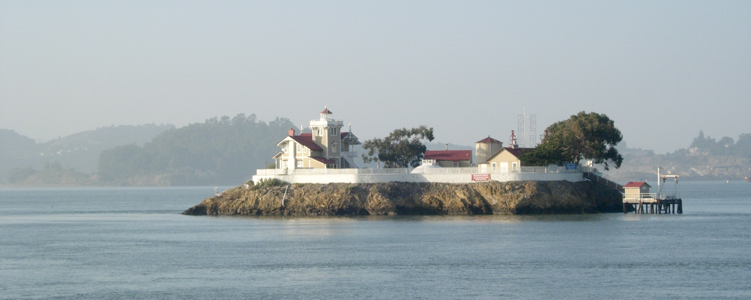The Gold Rush and the tremendous agricultural potential of California’s great Central Valley provided a great deal of the impetus for the development of seaports in what came to be known as the Inland Empire.

Photo by Joel Williams
By Captain Ray
Published: May, 2010
The Gold Rush and the tremendous agricultural potential of California’s great Central Valley provided a great deal of the impetus for the development of seaports in what came to be known as the Inland Empire. Sacramento, Stockton and other cities became jumping-off places for the gold fields and shipping ports for the Valley’s produce. Many vessels bypassed San Francisco and headed directly north to these inland ports.
The route took ships between Point San Pedro and Point San Pablo. While this opening, called San Pablo Strait, is over 1.5 miles wide, there are rocks off both points—the Sisters and the Brothers, off the Marin and Contra Costa shores, respectively—that narrow the opening significantly. These hazards, coupled with the frequent fog and tidal currents that can run as strong as at the Golden Gate, caused the United States Lighthouse Board to request the construction of a lighthouse and fog signal in that area. Money was appropriated for this purpose in 1871, but the government could not come to terms with local landowners for the purchase of a site. Eventually, it was decided to use East Brother Island, which was already federally owned.
Construction began in May 1873, when the top of the island was blasted away to create a level building site. A two-story Victorian house was erected. Attached to it was a three-story tower for the light. In addition to these structures, the completed plan included a steam-powered fog signal building, storage sheds, and a concrete-domed water cistern, surrounded by an inward-sloping, donut-shaped ring for water catchment. The lamp, which burned whale oil, was lit for the first time on March 1, 1874.
In the 1920s, a cable was laid along the bottom of the Bay from Pt. San Pablo to provide electricity to the island. A 500-watt bulb replaced the whale oil lamp, and a compressor-driven diaphone (a two-tone horn) replaced the steam-powered fog signal. The propeller of a ship damaged the cable in November 1939 and left the island on gasoline generator power while it was repaired. On March 4, 1940, while transferring gasoline, an accident resulted in a fire that burned the boathouse, pier and four boats. There was no telephone connection to the mainland and the island’s gravity-powered garden hose was not up to the task of fighting the fire. Alerted by a night watchman on a pier on Pt. San Pablo, the Coast Guard finally extinguished the fire about four hours after it started.
To save on maintenance costs, the Coast Guard planned to demolish the house and other structures on the island and replace them with a simple tower when it automated the light in the late 1960s. Protests by local residents prompted the Contra Costa Shoreline Parks Committee to get the station placed on the National Register of Historic Places in 1971. This prevented the demolition of the buildings, but there were no funds for maintaining them. The salt air took its toll: the paint failed, the iron rusted and the wood rotted.
In 1979, interested area residents formed East Brother Light Station, Inc. Functioning as a non-profit organization, it raised money from private donations and government grants. Using volunteer labor, it has restored the buildings. I had the pleasure of working with these volunteers last December, helping to install a new on-demand hot water heater. It now operates a unique bed and breakfast in the restored buildings and uses that income to maintain the buildings. If you’re interested in volunteering or making a reservation, the website is www.ebls.org, and the email address info@ebls.org.
Ray Wichmann, is a US SAILING-certified Ocean Passagemaking Instructor, a US SAILING Instructor Trainer, and a member of US SAILING’s National Faculty. He holds a 100-Ton Master’s License, was a charter skipper in Hawai’i for 15 years, and has sailed on both coasts of the United States, in Mexico, the Caribbean, and Greece. He is presently employed as the Master Instructor at OCSC Sailing in the Berkeley Marina.

